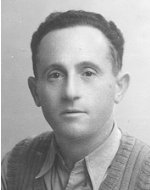Geller, Kalman
Son of-Shoshana and Binyamin, was born on the 13th of Tishrei, 1906, in the town of Radzievilov, Poland, where he completed his studies at the elementary school in Dubno, where he joined the Hashomer Hatzair youth movement and received pioneering training. After six weeks of “underground life,” the group managed to leave the town of Brody as tourists to visit the Carpathians and reached the city of Kolomyja, near the Romanian border, where they took care of them After two weeks, the group moved to Kfar Gidturka after three months of work The group began to cross the border in small groups in the direction of the city of Czernowitz in Bukovina Kalman swam in his clothes as he tried to cross the Dniester River and began to drown, and was barely drawn by his friends. “In the Galatasaray, Kalman worked as a woodcutter, was arrested a number of times and released with the help of the Palestine office, and Kalman spent about 15 months in Galatasi using false names. In December 1923 he and his group left for Eretz Israel and arrived in Israel in 1924. Immediately upon his arrival in Israel Kalman was an active member of the Haganah. In January 1924, the group was sent to work in tobacco plantations in Rosh Pina. At the end of that year, Kalman joined the Radzivilov group, which went down to the Kinneret for agricultural work. In 1926 the group dispersed and Kalman moved to Haifa. For many years he suffered from lack of work and hard living conditions, and worked part-time in carting. In June 1940 he was hired by the electric company as a driver and drove the company’s workers to work online whenever and whenever necessary, in times of disaster as in peacetime. When the battles of the War of Independence broke out at the end of 1947, after the UN General Assembly resolution of 29 November 1947 on the division of the land, he was forced to take a great risk because of his job, and he worked day and night at night. On March 18, 1948, Kalman fell in Acre with three of his friends, when they tried to restore electricity to the isolated settlements in the Western Galilee. He was brought to rest with his three friends in a mass grave in the Ramat Yohanan cemetery. He left behind a wife, a daughter and a son. Things about his life and his image appeared in the book “The Sons of Kiryat Haim in the War of Independence” and in the book “Our fallen comrades”.
